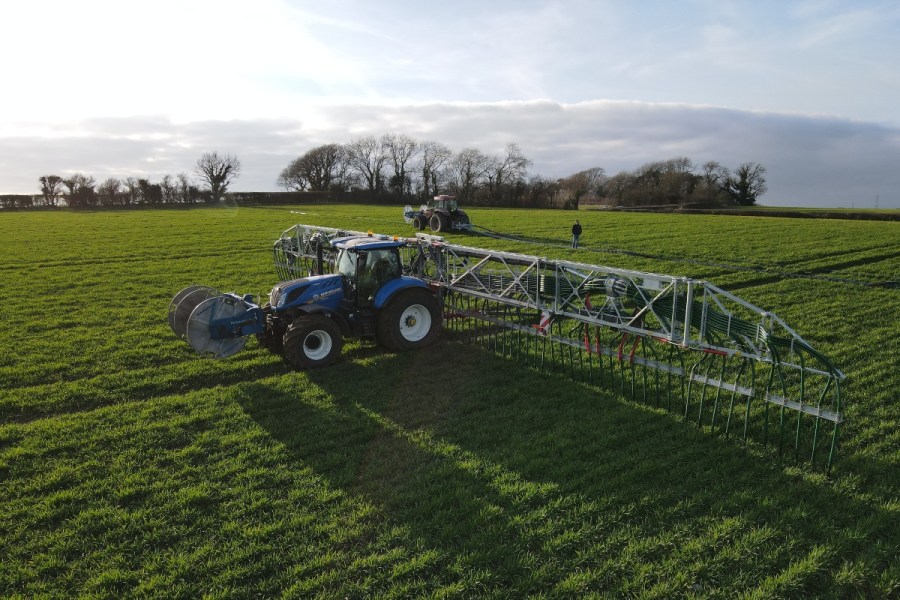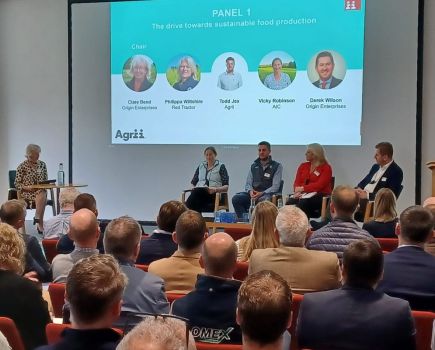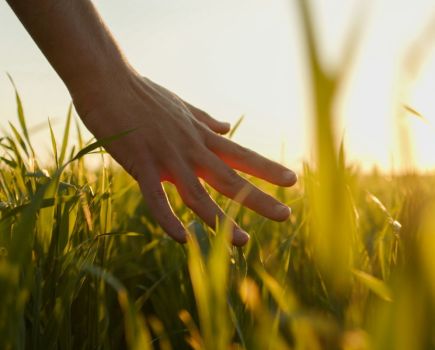Adopting good farming practices with soil health at their heart, along with a healthy dollop of manures, have helped a Welsh farm have a climate positive effect. CPM visits to find out how Tythegston Farm has got the right side of net zero.
Like companions with the OSR, white clover as a ‘permanent cover’ is a learning curve.
By Rob Jones
Net zero has never been a primary goal for Richard and Lynn Anthony and their team at Tythegston Farm, near Bridgend on the South Wales coast. But the latest Green Horizons Farm Carbon Toolkit calculations show the 1200ha they own and manage under a range of agreements across the Vale of Glamorgan are annually sequestering more than 21,000t CO2e.
More than anything else, such a positive contribution to carbon capture results from the progressive farming improvements made over the past 10 years, with the accent firmly on soil health, believes Richard.
“It’s really not complicated. You need to grow something to take in CO2.Then you have to hold it in your soil. Essentially, this means two things – keeping as much green cover as possible throughout the year and doing everything you can to build and maintain soil organic matter.
“At the end of the day, it all comes down to soil health, which is the key to our overall resilience and financial sustainability too.”
This philosophy has resulted in a six-year rotation, involving nine crop types, on ground that can grow maize and a five-year rotation, with six crops, on particularly heavy, wet land, he says.
Winter wheat is central to both rotations, with upwards of 450ha being grown alongside around 300ha of maize, 200ha of oilseed rape and 25ha of grass. Good local markets and the need for resilience means all the wheat is grown for feed, with a five-year average yield of just over 10t/ha.
On more favourable ground, wheat is followed by a mixture of winter rye and Westerwolds ryegrass and is grazed by sheep, then cut for silage ahead of maize planting in April. This sequence is repeated, followed by another crop of wheat, winter OSR and a catch crop of phacelia before going back to wheat, explains Richard.
Where maize can’t be grown, the wheat/winter OSR/phacelia/ wheat recipe is followed by two years of Italian ryegrass for silage then back into wheat.
“Having our own flock of 880 Lleyn-cross ewes, as well as winter grazing agreements with local sheep farmers, and a business supplying winter forage to dairy farms across south and west Wales, has allowed us to make the most of grass in both rotations as well as developing a substantial maize enterprise,” he explains.
“As an Agrii iFarm, we’ve also had the advantage of being able to test out a wide range of catch and cover crops, companions for our OSR, and different cropping and soil management opportunities, not to mention exploring the best wheats for our high septoria pressure environment.
“We’ve found winter rye and Westerwolds fit really well between our wheat and maize. They take-off rapidly to give a strong soil cover and both their deep and surface rooting is fantastic. Sheep grazing contributes to organic matter improvement and a cut of silage ahead of maize drilling is the icing on the cake,” he says.
“Phacelia has been our go-to catch crop for a while now. Its brilliant rooting works wonders for the soil and worms and the biomass it puts on in just 6-8 weeks means excellent nutrient capture. Having trialled a whole host of other species with Agrii, we’ll be adding vetches to it next year. While they don’t put on much top growth, the extent and depth of the rooting they achieve in the time is incredible,” says Richard.
Farm manager Dan Moore has been looking closely at soil health. “We’ve really stepped-up our OSR companion cropping in the past four years, mainly to find the best way of maintaining mycorrhizae and building other elements of soil health through the rotation.
“We’re not there yet, but our current combination of spring beans, buckwheat and purple vetch is looking good. Especially now we’ve adapted a second hand Mzuri drill to sow all the species at the right depths – the beans to around 10cm beside the legs (which go deeper), the buckwheat mixed with the OSR, and the vetch broadcast behind with a BioDrill,” he explains.
“The companions have certainly helped limit flea beetle problems, but their real beauty is the way they work together to support the OSR. The beans and vetch do a great job in rooting and nitrogen capture, while the buckwheat mines phosphate. With their support, all of our OSR averaged around 5t/ha last year.”
The Tythegson team has been quietly reducing tillage for a good 15 years now and would like to do so even further. Soils ranging from sand to heavy wet clays – with silt contents of up to 70% – plus 1250mm of annual rainfall, limits the no-till opportunities, says Richard.
The OSR apart, Väderstad Rapid drilling following a shallow pass with a Topdown (fitted with 50mm points for good soil loosening with the least mixing) is currently the standard practice. Sowing the phacelia with the Topdown allows the following wheat to be drilled directly. And a 12yo Horsch Sprinter, that’s seen a lot of work, provides a valuable wet weather drilling option, he says.
With such a strong local demand, all the cereal straw is baled. This means the business has had to rely on local authority compost and turkey litter, together with cover cropping to help build soil organic matters from around 2-3% to 7-8% for most of their ground now. The Farm Carbon Toolkit underlines the contribution this makes to Tythegson’s negative carbon footprint.
The farm also has a contract to manage digestate from a major carbon-neutral domestic waste AD plant right on its doorstep, which has also proved valuable in its carbon contribution. It’s involved a lot of investment in umbilical systems and 19,500 litre tankers with 24m dribble bar booms (justified by the substantial contracting business managed by their son, David) but this has allowed the farm to all but eliminate artificial fertilisation, according to Richard.
Normally accounting for around 25% of the carbon footprint on most farms, the nitrogen applications at Tythegson make-up just 2% its carbon footprint, despite wheat and OSR usage of around 280kgN/ha and 200kgN/ha, respectively.
By capping total organic N applications to 170kg/ha the current proposals to extend NVZs to all land in Wales would force a much greater use of bagged nitrogen, working against this fantastic achievement, he adds.
This, and the team’s desire to keep on improving soil health and with it their carbon footprint, is leading a number of further companion cropping, rotational and agronomic improvements to be explored with their Agrii agronomist, Chris Taylor.
Foremost amongst these is the introduction of white clover into the two-year IRG leys and then maintaining it under the wheat and right through to the OSR. The farm is also looking at growing a cash crop of lupins for local feed markets as a spring-sown alternative to maize.
“Like companions with the OSR, white clover as a ‘permanent cover’ is a learning curve,” says Chris. “The AberSheep we’re using has established well in the Italian Ryegrass. Hitting the grass with the right dose of glyphosate at the end of its life should enable us to carry the clover through and strip till the wheat into it using the Mzuri.
“This will mean we never have any bare soil, preserve the best soil structure, and take advantage of clover nitrogen fixation in both the wheat and OSR that follows,” he explains.
“We’ve had two years of very positive field-scale trials with lupins so far. Even though they weren’t sown until June and harvested in early October, they averaged 3.5t/ha last season with no fertiliser or crop protection inputs whatsoever.
“Add in the benefits of nitrogen fixing and they’re a very exciting opportunity here. We’re scaling-up lupin growing this coming spring but don’t want to get too carried away until we’ve fully explored the implications for the rotation.”
Dan adds: “We have to fit everything we do into our drive to reduce our reliance on chemicals too. This is no more than the best farming practice, but again it’s very positive for our carbon footprint as well as for the environment.
“We’re making good progress here by prioritising wheats that have stood out for their disease resistance in our iFarm trials – especially Graham, KWS Extase and, most recently, Fitzroy. Together with better balanced nutrition and growing in healthier soils with less inorganic nitrogen, this has allowed us to cut our fungicide bill by almost 50% in the past four years.”
With a local history of brome and ryegrass resistance problems, cutting back on herbicides is a major challenge. But using the most competitive wheat varieties, not drilling them too early, keeping year-round cover and having maize as a spring break are proving very valuable here, he believes.
He also highlights the importance of the two years silaging within the rotation, which happens well before the grass heads in the heavy land rotation.
Another important step in improving the Anthony’s farming resilience and carbon footprint is the wood chip boiler that has completely replaced gas for all their grain drying and given the opportunity to diversify into kiln-dried logs.
“Damp Augusts always used to be a big problem for us,” explains Richard. “But the sheer capacity of the vastly more efficient dry biomass heat we now have means we happily harvest at anything up to 26% moisture these days. It’s far more economic too, better for the environment and we don’t get any condensation in the sheds either.
“For us, it’s all a matter of farming better. We do this by looking hard at the issues we face and the opportunities we have; by never being afraid to try new things; and by making the most of those that work. And with better farming comes better sustainability in every way.”




